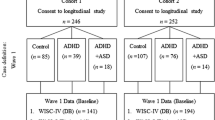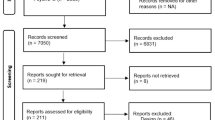Abstract
Purpose of Review
This review synthesizes the most relevant literature on similarities and differences between autism spectrum disorder (ASD) and attention deficit hyperactivity disorder (ADHD) in four developmental domains.
Recent Findings
Regarding executive functioning (EF), children with ASD present greater deficits in planning and flexibility, whereas problems with inhibitory control are more severe in ADHD. With respect to theory of mind (ToM) impairments, the ASD group is more affected, and difficulties occur later in ADHD. In pragmatics, both groups exhibit problems with coherence or inappropriate beginnings, however, children with ADHD have a better performance on stereotyped language and non-verbal communication. Finally, in contrast with children with ASD, participants with ADHD demonstrate knowledge of social skills, but they experience problems in performing social behaviors.
Summary
In terms of impairments, children with ADHD are located in an intermediate point between ASD and typical development (TD). Clinical implications are highlighted, and recommendations for future research are discussed.
Similar content being viewed by others
References
Papers of particular interest, published recently, have been highlighted as: • Of importance •• Of major importance
Gargaro BA, Rinehart NJ, Bradshaw JL, Tonge BJ, Sheppart DM. Autism and ADHD: how far have we come in the comorbidity debate? Neurosci Biobehav Rev. 2011;35:1081–8.
Willcutt EG. The prevalence of DSM-IV attention-deficit/hyperactivity disorder: a met-analytic review. Neurotherapeutics. 2012;9:490–9.
Christensen L, Baio J, Van Naarden K, Bilder D, Charles J, Constantino MD, et al. Prevalence and characteristics of autism spectrum disorders among children aged 8 years. Autism and developmental disabilities monitoring network, 11 sites, United States, 2012. Survell Summ. 2016;65:1–23.
•• Visser JC, Rommelse N, Greeven CU, Buitelaar J. Autism spectrum disorder and attention-deficit/hyperactivity disorder in early childhood: A review of unique and shared characteristics and developmental antecedents. Neurosci Biobehav Rev. 2016;65:229–63. The review is focused on the temperament (approach/surgency, negative affect, and effortful control) and executive function (working memory, inhibition, and cognitive flexibility) in ASD and ADHD from infancy to preschool years. It concludes that ASD and ADHD share negative affect, although with different motivational and behavioral dispositions. They also share deficits in control and flexibility, but with the implication of divergent behaviors.
• Miranda-Casas A, Baixauli-Fortea I, Colomer-Diago C, Roselló-Miranda B. Autism and attention deficit hyperactivity disorder: similarities and differences in executive functioning and theory of mind. Rev Neurol. 2013;57:177–84. The review suggests some different patterns of executive functioning in ASD and ADHD. Children with ADHD show failures in inhibitory control, while children with ASD have problems with cognitive flexibility and planning. Furthermore, younger children with ASD have greater deficiencies in the ToM compared to children with ADHD. The use of longitudinal designs might clarify how ToM evolvement affects poor executive functions development in both neurodevelopmental disorders.
Diamond A. Executive functions. Ann Rev Psychol. 2013;64:135–68.
Barkley RA. ADHD and the nature of self-control. New York: Guilford; 2005.
Lopez BR, Lincon AJ, Ozonoff S, Lai Z. Examining the relationship between executive functions and restrictive, repetitive symptoms of autistic disorder. J Autism Dev Disord. 2005;35:445–60.
Sinzig J, Vinzelberg I, Evers D, Lehmkuhl G. Executive function and attention profiles in preschool and elementary school children with autism spectrum disorders or ADHD. Int J Dev Disabil. 2014;60:144–54.
Salcedo MD, Moreno JM, Ruiz M, Ferrín M. Evaluation of planning dysfunction in attention deficit hyperactivity disorder and autistic spectrum disorder using the zoo map task. Child Psychiatry Hum Dev. 2013;44:166–85.
Matsuura N, Ishitobi M, Arai S, Kawamura K, Asano M, Hinohara K. Distinguishing between autism spectrum disorder and attention deficit hyperactivity disorder by using behavioral checklist cognitive assessment and neuropsychological test battery. Asian J Psychiatr. 2014;12:50–7.
Andersen PN, Hovik KT, Skogli EW, Egeland J, Ole M. Symptoms of ADHD in children with high-functioning autism are related to impaired verbal working memory and verbal delayed recall. PLoS One. 2013;8:e64842.
Semrud-Clikerman M, Walkowiak J, Wilkinson A, Butcher B. Executive functioning in children with Asperger syndrome, ADHD combined type, ADHD predominately inattentive type, and controls. J Autism Dev Disord. 2010;40:1017–27.
Hovik KT, Egeland J, Isquith PK, Gioia G, Skogli EW, Andersen PN, et al. Distinct patterns of everyday executive function problems distinguish children with Tourette syndrome from children with ADHD or autism spectrum disorders. J Atten Disord. 2014; first Published September 24.
Roselló B, Berrenguer C. Components of executive functioning in children with ASD and children with ADHD. Paper presented at VIII international meeting of psychology and education. Spain: Alicante; 2016.
Hartman CA, Geurts HM, Franke B, Buitelaar K, Rommelse N. Changing ASD-ADHD symptom co-occurrence across the lifespan with adolescence as crucial time window: illustrating the need to go beyond childhood. Neurosci Biobehav Rev. 2016;71:529–41.
Roberts BA, Martel MM, Nigg JT. Are there executive dysfunction subtypes within attention-deficit/hyperactivity disorder? J Atten Disord. 2017;21:284–93.
Baribeau DA, Doyle-Thomas KA, Dupuis A, Jaboni A, Crosbi J, Mc Ginn H, et al. Examining and comparing social perception abilities across childhood onset neurodevelopmental disorders. J Am Acad Child Adolesc Psychiatry. 2015;54:479–86.
Demopoulos C, Hopkins J, Davis A. A comparison of social cognitive profiles in children with autism spectrum disorders and attention-deficit/hyperactivity disorder: a matter of quantitative but not qualitative difference? J Autism Dev Disord. 2013;43:1157–70.
Demurie E, de Core M, Roeyers H. Empathic accuracy in adolescents with autism spectrum disorders and adolescents with attention-deficit/hyperactivity disorder. Res Autism Spect Disord. 2011;5:126–34.
•• Hutchins TL, Prelock PA, Morris H, Benner J, Lavigne T, Hoza B. Explicit vs. applied theory of mind competence: A comparison of typically developing males, males with ASD, and males with ADHD. Res Autism Spectr Disord. 2016;21:94–108. The level of complexity of the tasks was critical for distinguishing ToM skills of ADHD and ASD groups. Although children with ADHD can do well on traditional ToM tasks, they fail to apply this competence in the real world. The ToM difficulties of children with ASD have a generalized nature, suggesting a deeper metarepresentational deficit. These findings have implications for current models of social cognition in developmental disabilities.
Miranda A, Berenguer C, Roselló B, Baixauli I, Colomer C. Social cognition in children with autism spectrum disorder and attention deficit hyperactivity disorder. Connections to executive functions. (under review).
Buitelaar JK, Van der Wees M, Swaab-Barneveld H, Van der Gaag RJ. Theory of mind and emotion-recognition in autism spectrum disorders and in psychiatric control and normal children. Dev Psychopathol. 1999;11:39–58.
Downs A, Smith T. Emotional understanding, cooperation, and social behavior in high-functioning children with autism. J Autism Dev Disord. 2004;34:625–35.
Sinzig J, Morsch D, Lehmkuhl G. Do hyperactivity, impulsivity and inattention have an impact on the ability of facial affect recognition in children with autism and ADHD? Eur Child Adolesc Psychiatry. 2008;17:63–72.
Bühler E, Bachmann C, Goyert H, Heinzel-Gutenbrunner M, Kamp-Becker I. Differential diagnosis of autism spectrum disorder and attention deficit hyperactivity disorder by means of inhibitory control and ‘theory of mind’. J Autism Dev Disord. 2011;41:1718–26.
• Bora E, Pantelis C. Meta-analysis of social cognition in attention-deficit/hyperactivity disorder (ADHD): Comparison with healthy controls and autistic spectrum disorder. Psychol Med. 2016;46:699–716. This meta-analysis involved 44 studies comparing the performance of individuals with ADHD, ASD and TD in social cognition. The performance on ToM tasks was significantly worse in individuals with ASD than that in individuals with ADHD, but individuals with ADHD showed worse performance in the recognition of emotions and on ToM tasks than group with TD.
Adams C, Baxendale J, Llyod J, Aldredge C. Pragmatic language impairment: case studies of social and pragmatic therapy. Child Lang Teach Ther. 2005;21:227–50.
Grzadzinski R, Di Martino A, Brady E, Mairena MA, ONeale M, Petkova E, et al. Examining autistic traits in children with ADHD: does the autism spectrum extend to ADHD? J Autism Dev Disord. 2011;41:1178–91.
Helland WA, Biringer E, Helland T, Heimann M. Exploring language profiles for children with ADHD and children with Asperger syndrome. J Atten Disord. 2012;16:34–43.
Geurts HM, Embrechts MT. Language profiles in ASD, SLI, and ADHD. J Autism Dev Disord. 2008;38:1931–43.
Rumpf AL, Kamp-Becker I, Becker K, Kauschke C. Narrative competence and internal state language of children with Asperger syndrome and ADHD. Res Dev Disabil. 2012;33:1395–407.
•• Kuijper SJM, Hartman CA, Bogaerds-Hazenberg STM, Hendriks P. Narrative production in children with autism spectrum disorder (ASD) and children with attention-deficit/hyperactivity disorder (ADHD): similarities and differences. J Abnorm Psychol. 2017;126:63–75. This study focused on structural and pragmatic similarities and differences in narratives produced by children with ASD and children with ADHD and on the influence of ToM working memory, and response inhibition in language production. Children of both groups showed impairments on pragmatic measures and on syntactic complexity. ToM and working memory performance but not response inhibition were associated with many narrative skills.
Gardner DM, Gerdes AC. A review of peer relationships and friendships in youth with ADHD. J Atten Disord. 2015;19:844–55.
American Psychiatric Association. Diagnostic and statistical manual of mental disorders. Washington DC: American Psychiatric Association; 2013.
Turygin N, Matson JL, Tureck K. The relationship of attention-deficit hyperactivity disorder and autism spectrum disorder to adaptive skills in young children. Dev Neurorehabil. 2015;18:317–21.
Luteijn EF, Serra M, Jackson S, Steenhuis MP, Althaus M, Volkmar F, et al. How unspecified are disorders of children with a pervasive developmental disorder not otherwise specified? Eur Child Adolesc Psychiatry. 2000;9:168–79.
Cervantes PE, Matson J, Adams HL, Williams LW, Goldin RL, Jang J. Comparing social skill profiles of children with autism spectrum disorders versus children with attention deficit hyperactivity disorder: where the deficits lie. Res Autism Spect Disord. 2013;7:1104–10.
Lord C, Rutter M, DiLavore PS, Risi S. Autism diagnostic observation schedule (ADOS). Los Angeles: Western Psychological Services; 1999.
Salley B, Gabrielli J, Smitha C, Braun M. Do communication and social interaction skills differ across youth diagnosed with autism spectrum disorder, attention-deficit/hyperactivity disorder, or dual diagnosis? Res Autism Spectr Disord. 2015;20:58–66.
Grzadzinski R, Dick C, Lord C, Bishop S. Parent-report and clinician-observed autism spectrum disorder (ASD) symptoms in children with attention deficit/hyperactivity disorder (ADHD): implications for practice under DSM-5. Mol Autism. 2016;7:1–12.
Van der Meer JM, Oerlemans AM, van Stejin DJ, Lappenschaar MG, de Sonneville LM, Buitelaar JK, et al. Are autism spectrum disorder and attention-deficit/hyperactivity disorder different manifestations of one overarching disorder? Cognitive and symptom evidence from a clinical and population-based simple. J Am Acad Child Adolesc Psychiatry. 2012;51:1160–72.
Author information
Authors and Affiliations
Corresponding author
Ethics declarations
Conflict of Interest
Belén Roselló, Carmen Berenguer, Inmaculada Baixauli, Pilar Navio and Ana Miranda declare that they have no conflicts of interest.
Human and Animal Rights and Informed Consent
This article does not contain any studies with human or animal subjects performed by any of the authors.
Additional information
This article is part of the Topical Collection on ADHD
Rights and permissions
About this article
Cite this article
Roselló, B., Berenguer, C., Navío, P. et al. Executive Functioning, Social Cognition, Pragmatics, and Social Interaction in Attention Deficit Hyperactivity Disorder and Autism Spectrum Disorder. Curr Dev Disord Rep 4, 72–77 (2017). https://doi.org/10.1007/s40474-017-0114-1
Published:
Issue Date:
DOI: https://doi.org/10.1007/s40474-017-0114-1




